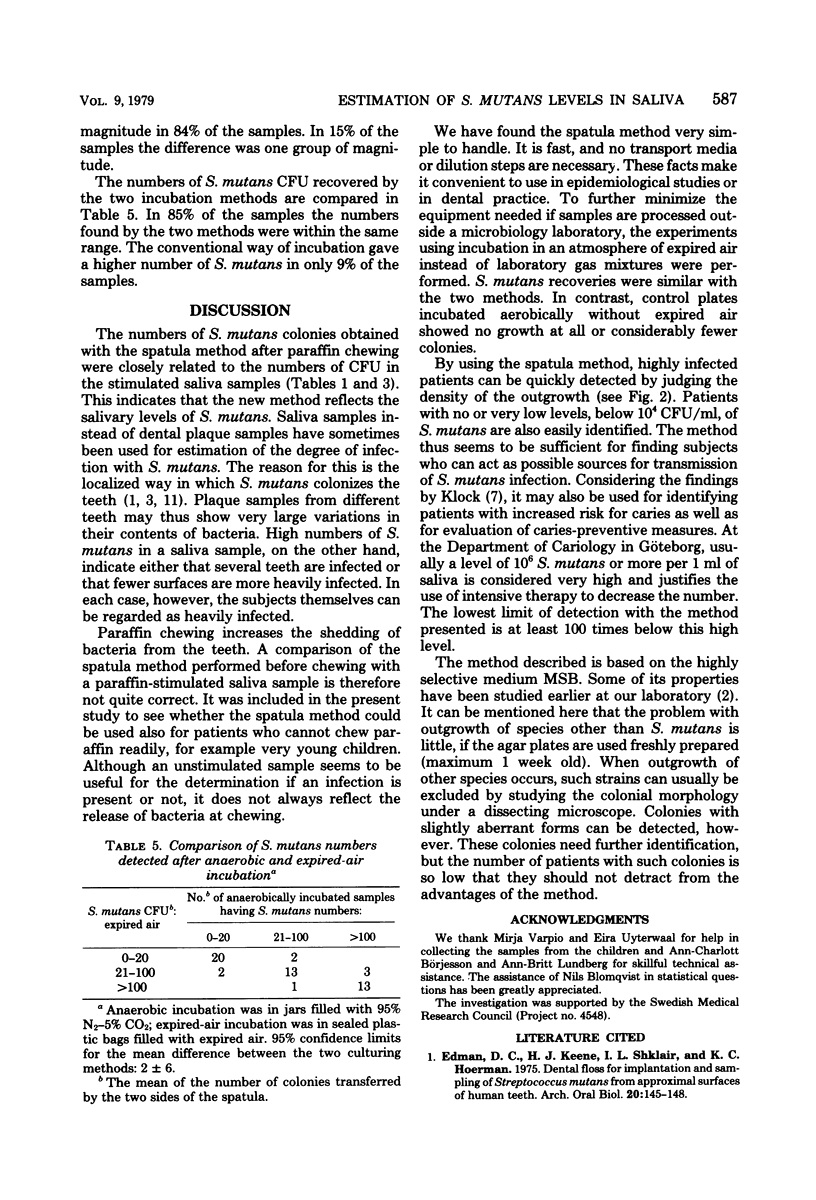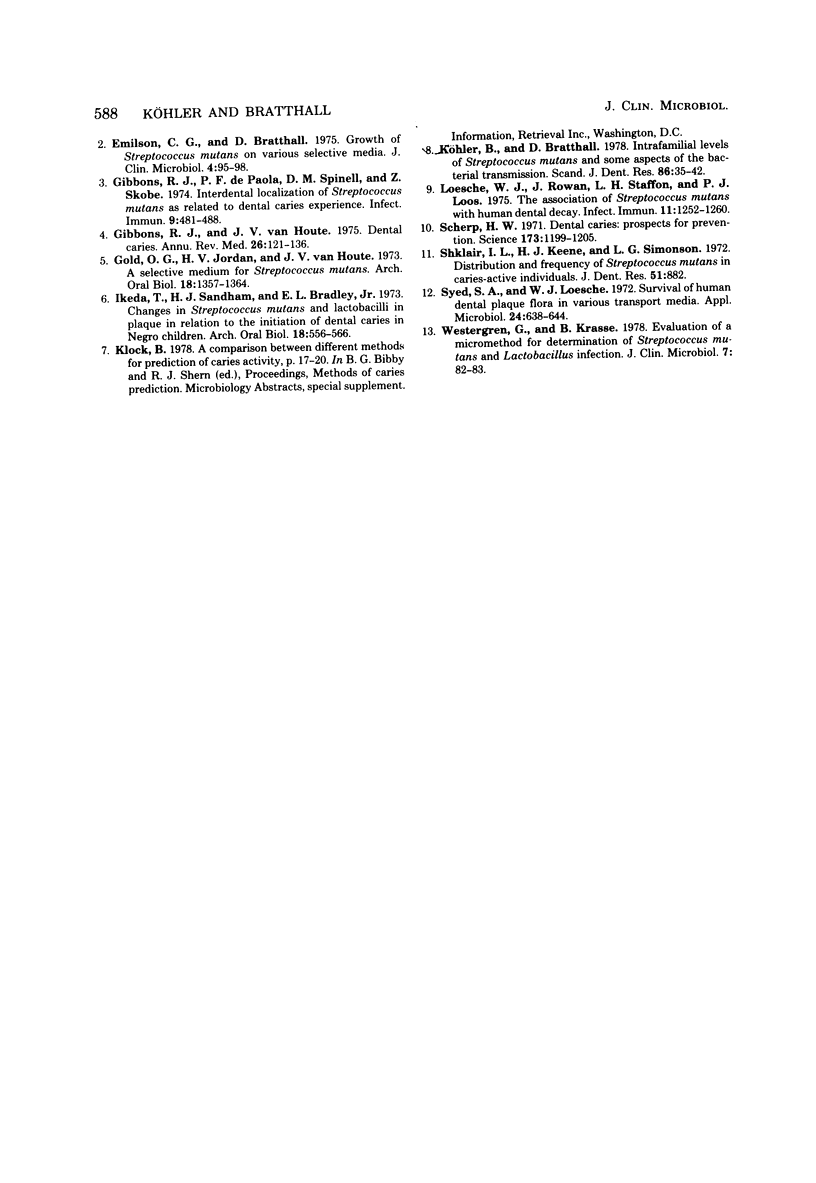Abstract
A method was developed to facilitate the estimation of Streptococcus mutans levels in saliva. Saliva-contaminated wodden spatulas were pressed directly against an elevated agar plate containing a selective medium. The results were compared with the number of S. mutans per 1 ml of paraffin-stimulated saliva. It was shown that the spatula method gave a good estimation of the level of S. mutans infection. The incubation was also made in expired air instead of 95% N2-5% CO2. The outgrowth was in good agreement with that after conventional incubation. The method is useful in epidemiological studies or in selecting persons at a high caries risk, and when ordinary saliva sampling cannot be done, for example in small children. Compared with conventional saliva sampling, this method requires less time and material at sampling as well as at the laboratory.
Full text
PDF




Images in this article
Selected References
These references are in PubMed. This may not be the complete list of references from this article.
- Edman D. C., Keene H. J., Shklair I. L., Hoerman K. C. Dental floss for implantation and sampling of Streptococcus mutans from approximal surfaces of human teeth. Arch Oral Biol. 1975 Feb;20(2):145–148. doi: 10.1016/0003-9969(75)90171-5. [DOI] [PubMed] [Google Scholar]
- Emilson C. G., Bratthall D. Growth of Streptococcus mutans on various selective media. J Clin Microbiol. 1976 Jul;4(1):95–98. doi: 10.1128/jcm.4.1.95-98.1976. [DOI] [PMC free article] [PubMed] [Google Scholar]
- Gibbons R. J., Depaola P. F., Spinell D. M., Skobe Z. Interdental localization of Streptococcus mutans as related to dental caries experience. Infect Immun. 1974 Mar;9(3):481–488. doi: 10.1128/iai.9.3.481-488.1974. [DOI] [PMC free article] [PubMed] [Google Scholar]
- Gibbons R. J., van Houte J. Dental caries. Annu Rev Med. 1975;26:121–136. doi: 10.1146/annurev.me.26.020175.001005. [DOI] [PubMed] [Google Scholar]
- Gold O. G., Jordan H. V., Van Houte J. A selective medium for Streptococcus mutans. Arch Oral Biol. 1973 Nov;18(11):1357–1364. doi: 10.1016/0003-9969(73)90109-x. [DOI] [PubMed] [Google Scholar]
- Ikeda T., Sandham H. J., Bradley E. L., Jr Changes in Streptococcus mutans and lactobacilli in plaque in relation to the initiation of dental caries in Negro children. Arch Oral Biol. 1973 Apr;18(4):555–566. doi: 10.1016/0003-9969(73)90076-9. [DOI] [PubMed] [Google Scholar]
- Köhler B., Bratthall D. Intrafamilial levels of Streptococcus mutans and some aspects of the bacterial transmission. Scand J Dent Res. 1978 Jan;86(1):35–42. doi: 10.1111/j.1600-0722.1978.tb00605.x. [DOI] [PubMed] [Google Scholar]
- Loesche W. J., Rowan J., Straffon L. H., Loos P. J. Association of Streptococcus mutants with human dental decay. Infect Immun. 1975 Jun;11(6):1252–1260. doi: 10.1128/iai.11.6.1252-1260.1975. [DOI] [PMC free article] [PubMed] [Google Scholar]
- Scherp H. W. Dental caries: prospects for prevention. Science. 1971 Sep 24;173(4003):1199–1205. doi: 10.1126/science.173.4003.1199. [DOI] [PubMed] [Google Scholar]
- Shklair I. L., Keene H. J., Simonson L. G. Distribution and frequency of streptococcus mutants in caries-active individuals. J Dent Res. 1972 May-Jun;51(3):882–882. doi: 10.1177/00220345720510034201. [DOI] [PubMed] [Google Scholar]
- Syed S. A., Loesche W. J. Survival of human dental plaque flora in various transport media. Appl Microbiol. 1972 Oct;24(4):638–644. doi: 10.1128/am.24.4.638-644.1972. [DOI] [PMC free article] [PubMed] [Google Scholar]
- Westergren G., Krasse B. Evaluation of a micromethod for determination of Streptococcus mutans and Lactobacillus infection. J Clin Microbiol. 1978 Jan;7(1):82–83. doi: 10.1128/jcm.7.1.82-83.1978. [DOI] [PMC free article] [PubMed] [Google Scholar]




